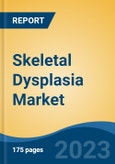Speak directly to the analyst to clarify any post sales queries you may have.
10% Free customizationThis report comes with 10% free customization, enabling you to add data that meets your specific business needs.
Key Market Drivers
Increasing Prevalence of Skeletal Dysplasia
The rising prevalence of skeletal dysplasia is a primary driver of the global skeletal dysplasia market, as it directly influences demand for diagnostic solutions, treatment options, medical research, and supportive healthcare services. This increasing prevalence is leading to higher patient volumes, greater healthcare investments, and enhanced innovation in the pharmaceutical and biotechnology industries. Skeletal dysplasias are relatively rare, with an estimated occurrence of one in every 4,000 to 5,000 births. However, the actual incidence may be higher than reported, as symptoms such as short stature, joint abnormalities, and other complications often remain undetected until early childhood.This delayed manifestation presents challenges in early diagnosis but also underscores the need for advanced genetic screening and specialized pediatric care, driving demand for targeted diagnostic and therapeutic solutions in the healthcare market. Genetic testing and early screening to identify skeletal dysplasia at birth or during pregnancy. Specialized orthopedic care to manage bone deformities and mobility issues. Long-term therapeutic solutions, such as growth hormone treatments and enzyme replacement therapies. This expanding patient base is a fundamental factor pushing healthcare providers, pharmaceutical companies, and medical device manufacturers to develop new and improved solutions for skeletal dysplasia management.
As more cases of skeletal dysplasia are identified, there is a rising need for accurate and early-stage diagnosis. The growing patient population is accelerating the adoption of: Next-generation sequencing (NGS) and genetic screening to detect hereditary skeletal dysplasia. Advanced imaging techniques, such as MRI, CT scans, and 3D ultrasound, to assess skeletal abnormalities. Biomarker-based testing to differentiate between various subtypes of skeletal dysplasia. As healthcare providers increasingly integrate early screening programs into prenatal and neonatal care, diagnostic companies stand to benefit significantly from the growing demand for high-precision testing solutions.
Key Market Challenges
Heterogeneity of Disorders
Skeletal dysplasias encompass a wide range of disorders, each with their own unique genetic mutations and clinical presentations. This heterogeneity complicates research and treatment efforts. Developing standardized approaches to diagnosis and treatment is challenging due to the diversity within this group of rare diseases.Key Market Trends
Genome Sequencing and Precision Medicine
Genomic sequencing technologies have become increasingly accessible and affordable, allowing for comprehensive genetic analysis of individuals with skeletal dysplasia. This trend is expected to continue, enabling healthcare providers to identify specific genetic mutations responsible for each patient's condition. As a result, precision medicine approaches will gain prominence, tailoring treatments to the individual's genetic makeup for more effective interventions.Key Market Players
- BioMarin
- Amgen Inc
- Merck KGaA
- Regeneron Pharmaceuticals Inc
- Alexion Pharmaceuticals Inc/MA
- Cipla Limited
- Eli Lilly and Company
- F. Hoffmann-La Roche AG
- Pfizer, Inc.
- AstraZeneca plc.
Report Scope:
In this report, the Global Skeletal Dysplasia Market has been segmented into the following categories, in addition to the industry trends which have also been detailed below:Skeletal Dysplasia Market, By Type:
- Achondroplasia
- Fibrodysplasia Ossificans Progressive
- Hypophosphatasia
- Multiple Osteochondromas
- X-linked Hypophosphatemia
Skeletal Dysplasia Market, By Treatment:
- Medication
- Surgery
Skeletal Dysplasia Market, By End User:
- Hospitals & Clinics
- Ambulatory Care Centers
- Others
Skeletal Dysplasia Market, By Region:
- North America
- United States
- Canada
- Mexico
- Europe
- Germany
- United Kingdom
- France
- Italy
- Spain
- Asia-Pacific
- China
- Japan
- India
- Australia
- South Korea
- South America
- Brazil
- Argentina
- Colombia
- Middle East & Africa
- South Africa
- Saudi Arabia
- UAE
- Kuwait
Competitive Landscape
Company Profiles: Detailed analysis of the major companies present in the Global Skeletal Dysplasia Market.Available Customizations:
With the given market data, the publisher offers customizations according to a company's specific needs. The following customization options are available for the report.Company Information
- Detailed analysis and profiling of additional market players (up to five).
This product will be delivered within 1-3 business days.
Table of Contents
Companies Mentioned
- BioMarin
- Amgen Inc
- Merck KGaA
- Regeneron Pharmaceuticals Inc
- Alexion Pharmaceuticals Inc/MA
- Cipla Limited
- Eli Lilly and Company
- F. Hoffmann-La Roche AG
- Pfizer, Inc.
- AstraZeneca plc.
Table Information
| Report Attribute | Details |
|---|---|
| No. of Pages | 180 |
| Published | March 2025 |
| Forecast Period | 2024 - 2030 |
| Estimated Market Value ( USD | $ 3.15 Billion |
| Forecasted Market Value ( USD | $ 4.72 Billion |
| Compound Annual Growth Rate | 6.9% |
| Regions Covered | Global |
| No. of Companies Mentioned | 10 |









